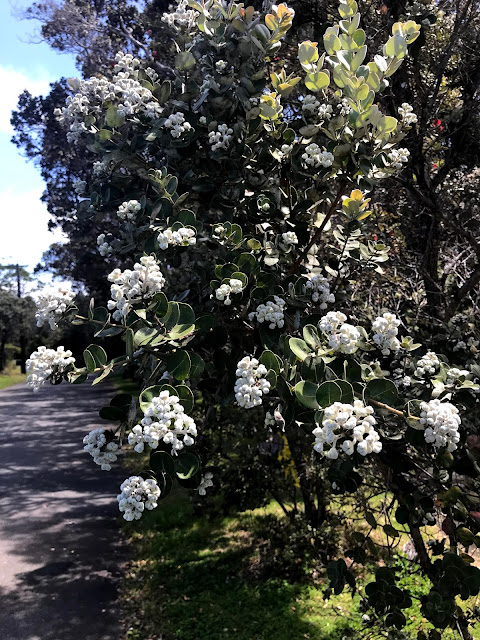I know. Itʻs been awhile. Many seem to understand that "retired" does not mean sitting in a rocking chair and whiling the days away. Those of us who are "retired" are in fact busier than when we were working. Perhaps thatʻs because we have lots more options to choose on the "What Shall I Do Today?" menu. We may end up saying Yes more often than we should, but ultimately, I believe, our varied activities help maintain our edge...
So. We survived a very very wet winter up here. More than five feet of rain during three or so months. Temperatures often did not rise much above 60dF during the day, but here we are. Early April was changeable, with some sun, more rain, and uncertainties. April 12 it was 43dF when the sun rose here at Keaʻau ma uka, and a week later in Hilo it was ikiiki hot sticky summer. Keeps us on our toes.
And the verdure in our verdant surroundings is happy. Friends share that often dry lee slopes of Hawaiʻi nei are also burgeoning with growth. Lehua, the floral symbol of our fair isle, is happily showing off and brightening our days. Red stamens blanket windshields and color pavement. In Hilo where we often see yards decorated with ʻōhiʻa bearing pua lehua of both red and yellow, the punctuations of color are welcome against green backdrops.
It all starts with ʻōpuʻu. Tight buds, often cloaked in white fur. The tree below is a pubescent one, wherein the ʻōpuʻu, liko (leaf shoots), and leaves themselves are downy.On another tree on the way to Keanakākoʻi, white-downed sepals enclose red-tinged petals. The bigger-gauge pistil unfurls first, soon followed by a multitude of lihilihi, delicate pollen-topped stamens.
A brief refresher: pollen from stamen tips lands on pistil tip via birds like ʻapapane as they feed, or wind-rustling, or... A pollen tube grows down in the pistil, and fertilizes eggs in the ovary. Work accomplished, stamens fall off followed by the pistil, grow and seed capsule fattens.
And looking and paying attention here in the forest, itʻs pepeʻe time. Coiled fronds of hāpuʻu are rising and unfurling. I never tire of watching and tracking their progress. Who says we donʻt have seasons? We of course do, but theyʻre much more subtle.
The three following yardphotos depict different stages of growth. It takes months for everybody to show off their fresh limegreen fronds, each proceeding at their own pace. The tight three was on February 8. And please note the different colors and stages of bases of fronds from previous three seasons.Then two pepeʻe hoʻoluʻe (unfurling as a flag) by my pahu wai (water tank). Enjoying seeing wisps of pulu attaching one to the other.
And, unusually, SEVEN rising on April 26. Kinda hard to photograph so theyʻre all identifiable, but there are indeed seven. The trunk of this hāpuʻu is especially thick, and I believe thatʻs why there are so many.
The UPDATE shares that Pele may be slowing down a bit. Please, no predictions. They invariably prove futile.
The amount of SO2 (sulphur dioxide) as measured is related to the effusion rate, or the volume of pele erupted. SO2 is a gas dissolved in magma, and is released (exolves) as pele reaches the surface. More pele = more gas.Meanwhile, overhead awesomeness. Weʻve just passed the fullmoons, but...
First below, a brightly moonlit night from the Maunaloa Strip Road. A ball of peleglow at the left, while on skyright: Hānaiakamalama, the Southern Cross!!! Alpha and Beta Centauri are the pointers. Bright stars on the left are part of Scorpio.
For those keeping track, tomorrow marks the third anniversary of the start of our most recent hulihia. And yes, Iʻll be posting a commemoration.
Till then, be well. Go get your shot(s). Iʻm pau with my Pfizer. All good, no issues other than small kine sore arm.
As always, with aloha,
BobbyC
maniniowali@gmail.com



















No comments:
Post a Comment